The term "blu pepper" typically refers to a misspelling or mispronunciation of "blue pepper," which isn't a standard culinary variety. True blue-colored peppers are extremely rare in nature, with most so-called "blue peppers" actually being immature ornamental varieties that turn red, orange, or yellow when ripe. The confusion often stems from mishearing "bell pepper" or searching for specialty products like Blue Pepper seasoning blends, which combine black pepper with other ingredients for unique flavor profiles.
When home cooks and culinary enthusiasts search for "blu pepper," they're usually encountering one of several common misunderstandings in the world of peppers. This comprehensive guide clarifies what "blue pepper" actually refers to, separates fact from fiction, and provides practical information for those seeking distinctive flavors for their cooking.
Understanding the Blue Pepper Confusion
The "blu pepper" search term represents a classic case of linguistic confusion in culinary terminology. Many home cooks searching for information about this mysterious ingredient don't realize they're likely looking for either bell peppers (phonetically similar) or specialty seasoning products. True blue-colored peppers don't exist as a standard commercial variety like black, white, or green peppercorns.
Botanically speaking, Capsicum annuum varieties—the species that includes most culinary peppers—don't naturally produce blue fruit. Some ornamental pepper plants display blue or purple hues during early development stages, but these quickly change to more conventional colors as the fruit matures. The blue coloration in young peppers comes from anthocyanins, the same pigments that give blueberries their color, but this characteristic disappears as the peppers ripen.

Actual Blue-Tinged Pepper Varieties
While no true "blue pepper" exists as a standard culinary ingredient, several varieties display blue or purple characteristics:
| Pepper Variety | Blue Characteristics | Mature Color | Culinary Use |
|---|---|---|---|
| Blue Java | Purple-blue when immature | Red | Ornamental, mild heat |
| Blue Cone | Deep purple when young | Bright red | Edible, medium heat |
| Apache | Purple streaks on green fruit | Red | Edible, medium heat |
| Blue Peter | Purple-blue skin | Red | Sweet pepper alternative |
These varieties develop their distinctive blue or purple coloration due to anthocyanin pigments, which are temperature-sensitive and typically fade as the peppers mature. Gardeners in cooler climates may notice more pronounced blue hues, as anthocyanin production increases in lower temperatures.
Distinguishing Between Common Pepper Confusions
The "blu pepper" search often stems from confusion between several similarly named products:
- Bell peppers - Frequently misheard as "blu peppers" due to similar pronunciation
- Blue Pepper seasoning - Commercial blends typically combining black pepper with other ingredients
- Blue Java banana - Sometimes mistakenly called "blue pepper" in regional dialects
- Blue corn - Occasionally confused in agricultural contexts
Understanding these distinctions is crucial for both home cooks and professional chefs seeking specific flavor profiles. When searching for culinary ingredients, precise terminology matters significantly for achieving desired results.
Culinary Applications of Blue-Tinged Peppers
While true blue peppers don't exist as a standard culinary ingredient, the blue-tinged varieties offer unique characteristics for creative cooking:
Ornamental blue peppers like the Blue Java typically register between 5,000-10,000 Scoville units, placing them in the medium heat range. Their flavor profile features initial sweetness followed by moderate heat, making them versatile for salsas, pickling, and roasted dishes. The visual appeal of these peppers makes them particularly valuable for gourmet presentations where color contrast enhances the dining experience.
Chefs specializing in farm-to-table cuisine sometimes incorporate immature blue peppers for their subtle flavor differences compared to fully ripened counterparts. The anthocyanins present in these young peppers may offer additional antioxidant properties, though research in this area remains limited.

Shopping Guide for Specialty Peppers
Finding genuine blue-tinged peppers requires knowing where to look and what to ask for:
- Local farmers markets - Specialty growers often cultivate unique pepper varieties
- Seed catalogs - Look for "purple" or "blue" varieties like Blue Java or Blue Cone
- Specialty grocery stores - Higher-end markets sometimes carry unique pepper varieties
- Online retailers - Several agricultural suppliers ship live plants
When shopping, be specific about what you're seeking. Ask for "peppers with blue or purple immature fruit" rather than simply "blue peppers" to avoid confusion. Many grocery store employees aren't familiar with the botanical development stages of peppers and may direct you to standard bell peppers instead.
For those interested in the distinctive flavor of specialty pepper blends marketed as "blue pepper," check gourmet spice shops or online retailers specializing in rare seasonings. These products typically combine Tellicherry black peppercorns with other ingredients like blue fenugreek or blue corn to create complex flavor profiles.
Common Misconceptions About Blu Pepper
Several persistent myths surround the concept of "blu pepper" that deserve clarification:
- Myth: Blue pepper is a distinct species like black or white pepper
Reality: No such distinct species exists in commercial cultivation - Myth: Blue pepper has unique health benefits compared to other peppers
Reality: Any health benefits come from standard pepper compounds, not blue coloration - Myth: Blue pepper is significantly hotter than standard varieties
Reality: Heat levels depend on capsaicin content, not color
Understanding these distinctions helps consumers make informed choices when exploring specialty ingredients. The world of peppers offers incredible diversity, but accurate terminology ensures you get exactly what you're looking for.











 浙公网安备
33010002000092号
浙公网安备
33010002000092号 浙B2-20120091-4
浙B2-20120091-4